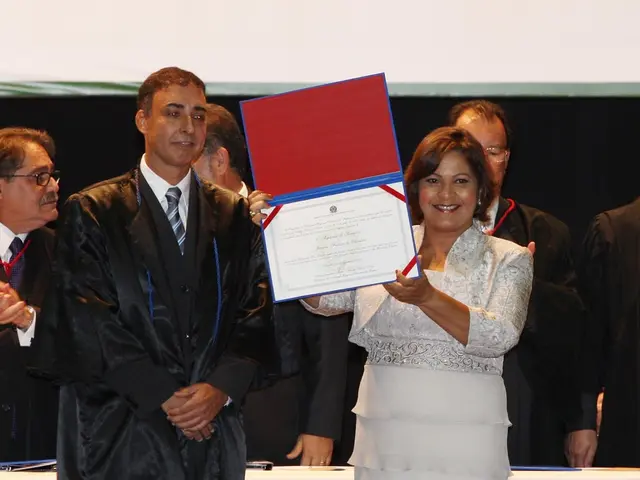Implementing AI Guidelines in Career Advancement Training Plans
In the vibrant educational landscape of Lyons Township High School, Callie Salaymeh, an Instructional Technology Coach and Biology teacher, is spearheading an innovative professional development (PD) plan that aims to integrate Artificial Intelligence (AI) guidelines for effective navigation by students and teachers.
As the Head of Community for Enlightened AI, Salaymeh has been at the forefront of this initiative, collaborating with tech leaders and educators within a Slack community to develop a comprehensive PD session based on AI. This plan, introduced in August 2024, was recently recognised at a Tech & Learning Regional Leadership Summit with an Innovative Leader Award for the Best Example of Professional Development.
Salaymeh's focus during the last semester of spring 2024 was on increasing AI literacy among staff. To achieve this, she and her team used resources from TeachAI and AI for Education to create AI stop light guidelines. These guidelines, now a cornerstone of the PD plan, help determine whether AI can be utilised in a given assignment. Assignments are categorised into three categories: Green Light, Yellow Light, and Red Light.
A Green Light assignment allows students to use generative AI to complete a project, while a Red Light assignment prohibits its use. A Yellow Light assignment permits limited use of generative AI at the teacher's discretion.
Salaymeh emphasises the importance of involving students in the discussion when creating AI guidelines. She believes that this approach encourages a deeper understanding of AI and its applications among both teachers and students.
In the district where Salaymeh works, there are five technology coaches for a staff of 280 teachers and about 500 faculty members. The PD plan, therefore, is designed to cater to a diverse range of needs and comfort levels with technology.
The plan employs a variety of PD delivery models tailored to staff needs. These include microlearning bursts, hybrid workshops, job-embedded coaching, cohort courses, and professional learning communities. The goal is to provide ongoing training, practical application opportunities, and ethical frameworks for AI use both personally and professionally.
Moreover, the PD plan emphasises ethical AI use and instructional alignment. School leaders and teachers learn to craft precise AI prompts, vet AI-generated feedback carefully, and ensure AI augments rather than replaces human expertise. Integrating district or state AI guidelines, including privacy protections and bias guardrails, is necessary to maintain trust and safeguard equitable access.
To build sustainable adoption and teacher buy-in, the PD plan is supported by a clear multi-year commitment with transparent milestones and communication. Allowing voluntary tech support and pairing more tech-savvy teachers with others helps address varied comfort levels. Schools should allocate sufficient time for teachers to learn, test, and collaborate on AI tools, going beyond one-off sessions to ensure meaningful skill development and thoughtful implementation.
In conclusion, Salaymeh's AI-integrated PD plan is teacher-centered, paced appropriately, ethically grounded, aligned to instructional goals, supported by coaching and collaboration, and committed to long-term continuous improvement. This approach enables teachers to confidently and effectively navigate AI use in their professional and personal roles, ultimately improving teacher efficiency and work-life balance.
[1] Microlearning bursts, hybrid workshops, job-embedded coaching, cohort courses, and professional learning communities (adapted from Salaymeh's PD plan)
[2] Ethical AI use and instructional alignment (adapted from Salaymeh's PD plan)
[3] District or state AI guidelines, including privacy protections and bias guardrails (adapted from Salaymeh's PD plan)
[4] Allowing voluntary tech support and pairing more tech-savvy teachers with others (adapted from Salaymeh's PD plan)
[5] Sufficient time for teachers to learn, test, and collaborate on AI tools (adapted from Salaymeh's PD plan)
- At Lyons Township High School, Callie Salaymeh, an Instructional Technology Coach and Biology teacher, is spearheading a comprehensive professional development (PD) plan that integrates Artificial Intelligence (AI) for effective navigation by students and teachers.
- Salaymeh's PD plan utilizes microlearning bursts, hybrid workshops, job-embedded coaching, cohort courses, and professional learning communities to provide ongoing training and practical application opportunities for staff.
- To ensure ethical AI use and instructional alignment, the plan includes district or state AI guidelines, such as those focusing on privacy protections and bias guardrails.
- To address varying comfort levels with technology, the plan allows for voluntary tech support and pairs more tech-savvy teachers with others.
- Teachers are allocated sufficient time to learn, test, and collaborate on AI tools in Salaymeh's PD plan, ensuring meaningful skill development and thoughtful implementation.
- Ultimately, Salaymeh's teacher-centered, paced, ethically grounded, and aligned to instructional goals PD plan aims to improve teacher efficiency, work-life balance, and personal growth within the education-and-self-development landscape.




